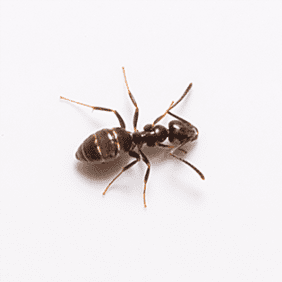Carpenter Ant – Carpenter ants vary in size, generally from 1/2” to 5/8” in length. These ants may be black and red, or completely black, red, or brown. Common throughout New England, these ants commonly infest wooden buildings or structures, causing major structural damage.
Evidence of an infestation includes: worker ants foraging, sawdust or fragments of insulation, and/or insect body parts.
Bees
Honey bees have a narrow, oval shaped appearance with golden-yellow and brown bands. Adult honey bee workers are about ½ -5/8th of an inch in length; queens are slightly larger. They are covered in pale hairs and have a visible barbed stinger.
Bees lie at the heart of our survival. They pollinate 1 in 3 bites of food we eat and are essential to the health and prosperity of countless ecosystems.
Seeing large numbers of honey bees flying near or in your home is a sign of an infestation. The best course of action is to contact a local beekeeper. They will come remove the nest safely. And the bees will be safe to continue pollinating and living their best lives.

Rodents
As shocking as it may seem, an astounding 37 percent of homeowners saw rodents in their homes in 2017. This number is up seven percent when compared to 2013, proving that America’s rodent infestations are on the rise.
This is, unfortunately, especially true in New England, where winter temperatures typically fall below freezing. Rats and mice alike need to be warm to survive, but they cannot hibernate like chipmunks or fatten up like squirrels. While they take refuge in warmer areas, such as your home, they often produce plenty of offspring, worsening your rodent problems as spring approaches.

Odorous House Ant – Becoming increasingly abundant in the New England area, these ants forage mainly for honeydew, eventually invading structures and setting up massive, multi-queen colonies. Homeowners will generally spot these ants in their kitchen foraging for a water source and/or sweets. Odorous house ants range in color from brown to black and are roughly 1/16” to 1/8” in length. When crushed, these ants give off a smell similar to rotten coconut.

Tick & Mosquito Control
Did you know that 95% of all confirmed Lyme disease cases have been reported from just 14 states? Or that these 14 states included the entire New England region?
Lyme disease is defined as “an inflammatory disease characterized at first by rash, headache, fever, and chills, and later by possible arthritis and neurological and cardiac disorders, caused by bacteria that are transmitted by ticks.”
Deer ticks, in particular, are the breed of tick that carries the disease, and they are far too prevalent in the New England region to be ignored. Although wooded areas are ideal for tick activity, with the growing population of deer, tick activity is becoming more common in all areas of New England. Griggs & Browne tick control services can help lessen your risk of disease by reducing the population of ticks around your property.


Bed Bugs
The presence of bed bugs in American homes is undoubtedly increasing, as 97% of all pest professionals have been called on to treat them within the last year.
Bed bugs are pests attracted to warmth, blood, and carbon dioxide. They are nocturnal insects, hiding away in the folds of the mattress, box spring, and other hidden locations, waiting for you to settle in for a good night’s rest… or so you thought. Bed bugs will typically come out of hiding to feed in the late night and/or early morning hours. People cannot feel the biting occurring, but will typically wake up to bite marks that are generally painless at first, but later turning into itchy welts. Where do bed bugs hide? The short answer: ANYWHERE. Some of the most common bed bug hiding places include, but are not limited to:
Because there are so many areas where bed bugs can live and travel, the process for eliminating an infestation can be extensive, thus requiring intense preparation. Fortunately, Griggs & Browne’s team of experts is here to help you make it through such a perilous situation. Bed bugs are common for families living in all different types of areas, whether it is a single-family house, townhouse, condo, or even an apartment complex. Bed bugs do not discriminate, so if there is a situation that needs to be handled, you can rest easy knowing that Griggs & Browne is on the case.

Termites are a wood destroying insect that cause over $5 billion of damage per year. The most common in the U.S. and New England is the eastern subterranean termite (Reticulitermes flavipes), which nests underground for the most part and require mud tubes as shelter for above ground movement. New England has a high termite pressure which means there is no shortage of termites and every home is at risk. The most recent studies show that the average home will have 2 colonies per property. All a termite needs is a 1/16 of an inch to enter your home or business. Termite infestations are not easy to spot and they can do incredible amounts of damage before the visual evidence is even seen. If you fear you may be dealing with a termite infestation or want to prevent and protect your investment from an attack, Griggs & Browne urges you to call our team of experts immediately, as your family’s home could indeed be at risk.
